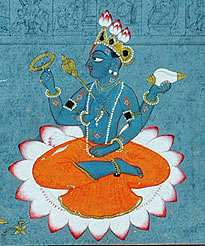Achintya Bheda Abheda
| Part of a series on |
| Vaishnavism |
|---|
 |
|
Sampradayas |
|
Philosophers–acharyas |
|
Related traditions |
|
|
| Part of a series on | ||
| Hindu philosophy | ||
|---|---|---|
 | ||
| Orthodox | ||
|
|
||
| Heterodox | ||
|
|
||
|
||
Achintya-Bheda-Abheda (अचिन्त्यभेदाभेद, acintyabhedābheda in IAST) is a school of Vedanta representing the philosophy of inconceivable one-ness and difference.[1] In Sanskrit achintya means 'inconceivable',[1] bheda translates as 'difference', and abheda translates as 'non-difference'. The Gaudiya Vaishnava religious tradition employs the term in relation to the relationship of creation and creator (Krishna, Svayam Bhagavan),[2][3] between God and his energies.
It is believed that this philosophy was taught by the movement's theological founder Chaitanya Mahaprabhu[4] (1486 - 1534) and differentiates the Gaudiya tradition from the other Vaishnava Sampradayas. It can be understood as an integration of the strict dualist (dvaita) theology of Madhvacharya and the qualified monism (vishishtadvaita) of Ramanuja, rejecting the absolute non-dualism (advaita) of Adi Shankara which contradicts Vyāsadeva's siddhānta.
Historical perspective
Historically within Hinduism there are two conflicting philosophies regarding the relationship between living beings (Jiva or Atma) and God (Ishvara, Brahman or Bhagavan). Advaita schools assert the monistic view that the individual soul and God are one and the same,[5] whereas Dvaita schools give the dualistic argument that the individual soul and God are eternally separate.[6] The philosophy of Achintya-bheda-abheda includes elements of both viewpoints. The living soul is intrinsically linked with the Supreme Lord, and yet at the same time is not the same as God - the exact nature of this relationship being inconceivable to the human mind. The spirit Soul is considered to be part and parcel of the Supreme Lord. Same in quality but not in quantity. The Supreme Lord Sri Hari having all opulence in fullness, the spirit soul however having only a partial expression of His divine opulence. The Lord in this context is compared to a fire and the spirit souls as sparks coming off of the flame.
Philosophy
The theological tenet of achintya-bheda-abheda tattva reconciles the mystery that God is simultaneously "one with and different from His creation". In this sense Vaishnava theology is panentheistic as in no way does it deny the separate existence of God (Vishnu) in His own personal form. However, at the same time, creation (or what is termed in Vaishnava theology as the 'cosmic manifestation') is never separated from God. He always exercises supreme control over his creation. Sometimes directly, but most of the time indirectly through his different potencies or energies (Prakrti). Examples are given of a spider and its web; earth and plants that come forth and hair on the body of human being.[7]
Difference in concept to Advaita Vedanta
It is clearly distinguished from the concept of anirvacaniya (inexpressible) of Advaita Vedanta. There is a clear difference between the two concepts as the two ideas arise for different reasons. Advaita concept is related to the ontological status of the world, whereas both Svayam bhagavan and his shaktis (in Lord himself and his powers) are fully real, and they are different from each other, but at the same time they are the same. But that does not negate the reality of both.[1] The Brahmavadi concept is a direct opposite and a contradicting concept to an early Krishna-theism.[8]
Exceptions
While it applied to relations between Purusha (the Lord) and Prakriti (be it material, marginal, or spiritual powers), in the theology of the concept there are areas of exceptions. Jiva Goswami also accepts that any object and its energy are non-different, such as fire and power of burning. While some maintain that its only a secondary extension of the principle that it is primarily applied to Svayam bhagavan and His energies. It does not, however, apply to differences between Avatars of Svayam bhagavan and Lord Himself, so the difference between Vishnu and His origin, is not covered by the concept of acintya bhedabheda, i.e. it cannot be applied in cases where different levels of Purusha are compared.[1]
See also
References
- 1 2 3 4 Gupta, Ravi M. (2007). Caitanya Vaisnava Vedanta of Jiva Gosvami's Catursutri tika. Routledge. ISBN 0-415-40548-3.pp. 47-52
- ↑ {{cite book | author = Kaviraja, K.G. It is the living entity's constitutional position to be an eternal servant of Krishna because he is the marginal energy of Krishna and a manifestation simultaneously one with and different from the Lord, like a molecular particle of sunshine or fire."
- ↑ Kṛṣṇa Upaniṣad 1.25: ...na bhinnam. nā bhinnamābhirbhinno na vai vibhuḥ
- ↑ "Lord Chaitanya taught that as spirit souls we are part of God and thus we are not different with Him in quality, and yet at the same time we are also different from Him in quantity. This is called acintya-bheda-abheda-tattva, inconceivable, simultaneous oneness and difference."
- ↑ "Additional information". Tatfoundation. Archived from the original on 12 May 2008. Retrieved April 16, 2008. "This interpretation of the Upanishads, that the individual soul and God are absolutely non-different, is what distinguishes advaita from other forms of Vedanta."
- ↑ "Additional information". dvaita.org. Archived from the original on 12 April 2008. Retrieved April 16, 2008. "Dvaita,... asserts that the difference between the individual soul or Jiva, and the Creator, or Ishvara, is eternal and real"
- ↑ yathorṇa-nābhiḥ sṛjate gṛhṇate ca yathā pṛthivyām oṣadhayaḥ sambhavanti yathā sataḥ puruṣāt keśa-lomāni tathākṣarāt sambhavatīha viśvam - Muṇḍaka Upaniṣad 1.1.7
- ↑ S. Devadas Pillai, ed. (1997). Indian Sociology Through Ghurye: A Dictionary. Columbia, Mo: South Asia Books. p. 403. ISBN 81-7154-807-5.